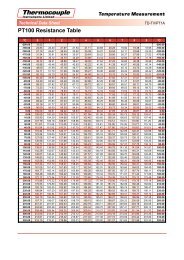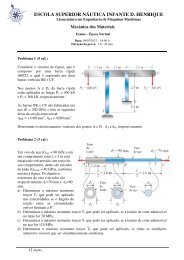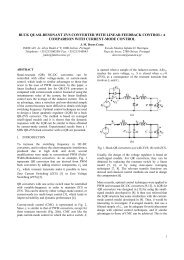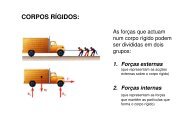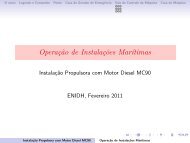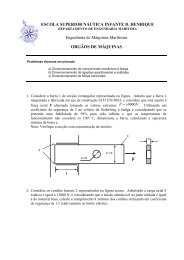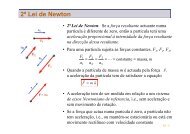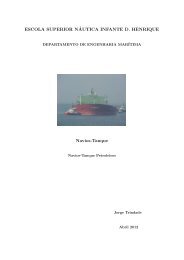Textos de Apoio (pdf)
Textos de Apoio (pdf)
Textos de Apoio (pdf)
You also want an ePaper? Increase the reach of your titles
YUMPU automatically turns print PDFs into web optimized ePapers that Google loves.
Derating: a solution for<br />
high fuel savings and lower emissions<br />
Rudolf Wettstein 1 & David Brown 2<br />
Wärtsilä Switzerland Ltd, Winterthur<br />
Summary<br />
This paper sets out ways to achieve worthwhile reductions in the fuel consumption of Wärtsilä low-speed engines<br />
when <strong>de</strong>signing newbuildings. The key approach is to use the flexibility offered by the full power/speed layout field to<br />
select a better layout point at a <strong>de</strong>rated power with a lower BSFC and also possibly a higher propeller efficiency.<br />
Introduction<br />
Fuel efficiency and environmental friendliness are<br />
high on the list of requirements for ship propulsion<br />
engines from today’s shipping- and shipbuilding<br />
industries. Thus Wärtsilä is committed to creating<br />
better technology in these areas that will benefit both<br />
the customers and the environment.<br />
Yet it is often forgotten by many ship <strong>de</strong>signers<br />
and those specifying low-speed main engines that<br />
advantage can be taken of the power/speed layout<br />
field of Wärtsilä low-speed engines to select an engine<br />
rating point with a still lower fuel consumption.<br />
The concept of the power/speed layout field for<br />
low-speed marine diesel engines originated in the<br />
1970s. The layout options were step-by-step wi<strong>de</strong>ned<br />
until, in 1984, our low-speed engines began to be<br />
offered with a broad power/speed layout field. An<br />
engine’s contracted maximum continuous rating<br />
(CMCR) can be selected at any point in the power/<br />
speed field <strong>de</strong>fined by the four corner points: R1,<br />
R2, R3 and R4 (Fig. 1). The rating point R1 is the<br />
maximum continuous rating (MCR) of the engine.<br />
Most recently, the layout fields for certain<br />
engines, the RT-flex82C, RTA82C, RT-flex82T and<br />
RTA82T, are exten<strong>de</strong>d to increased speeds for the<br />
R1+ and R2+ points (Fig. 2). The exten<strong>de</strong>d fields<br />
offer wi<strong>de</strong>ned flexibility to select the most efficient<br />
propeller speed for lowest daily fuel consumption,<br />
and the most economic propulsion equipment,<br />
1<br />
Rudolf Wettstein is Director, Marketing &<br />
Application Development, Ship Power, Wärtsilä<br />
Switzerland Ltd.<br />
2<br />
David Brown is Manager, Marketing Support,<br />
Wärtsilä Switzerland Ltd.<br />
Engine power, %R1<br />
100<br />
90<br />
80<br />
70<br />
60<br />
70<br />
Higher propulsive<br />
efficiency<br />
R3<br />
R4<br />
80<br />
Constant torque line<br />
90<br />
R1<br />
0<br />
-1 ∆BSFC<br />
-2 g/kWh<br />
-3<br />
-4<br />
-5<br />
100<br />
Engine speed, %R1<br />
Fig. 1: Typical layout field for RTA and RT-flex engines. The<br />
contracted maximum continuous rating (CMCR) can be<br />
selected at any point, such as Rx, within the layout field. The<br />
∆BSFC is the reduction in full-load BSFC for any rating<br />
point Rx relative to that at the R1 rating.<br />
[08#044]<br />
Rx<br />
R2<br />
-6<br />
-7<br />
Lower<br />
specific<br />
fuel<br />
consumption<br />
namely the propeller, shafting, etc.<br />
One basic principle of the engine layout field is<br />
that the same maximum cylin<strong>de</strong>r pressure (Pmax)<br />
is employed at all CMCR points within the layout<br />
field. Thus the reduced brake mean effective pressure<br />
(BMEP) obtained at the reduced power outputs in<br />
the field results in an increased ratio of Pmax/BMEP<br />
and thus lower brake specific fuel consumption<br />
(BSFC).<br />
The other principle behind the layout field is<br />
— 1 — © Wärtsilä Corporation, June 2008


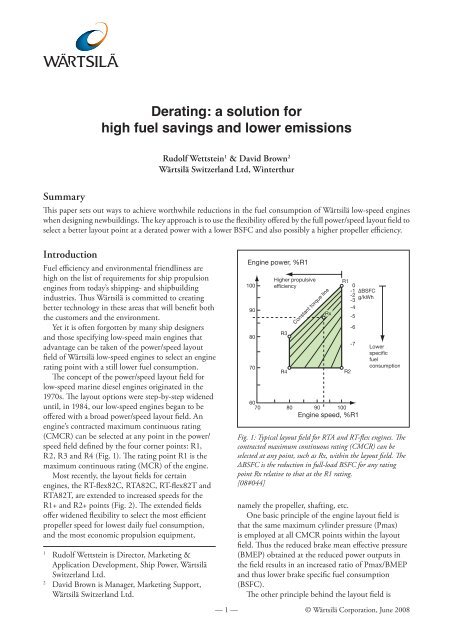
![Conceitos transmissao de dados .Sinais[.pdf]](https://img.yumpu.com/50982145/1/190x146/conceitos-transmissao-de-dados-sinaispdf.jpg?quality=85)
![Packages e interfaces[.pdf]](https://img.yumpu.com/50629553/1/190x134/packages-e-interfacespdf.jpg?quality=85)
